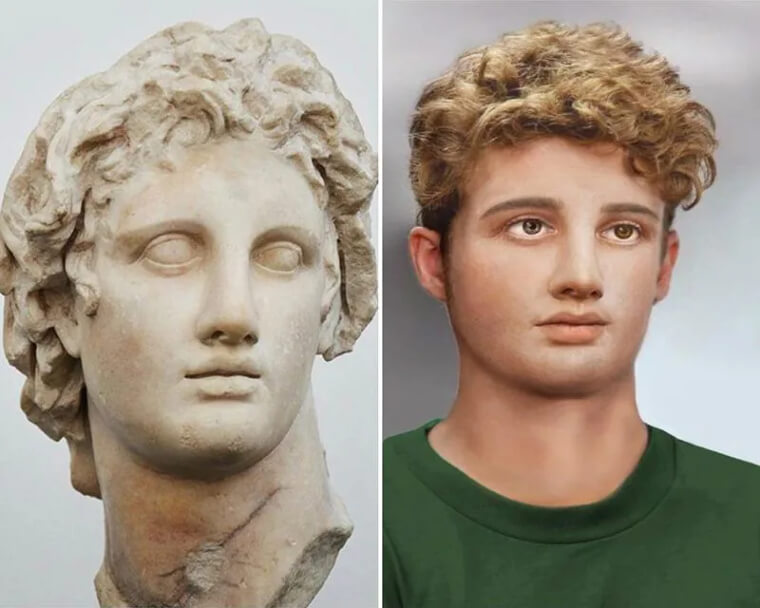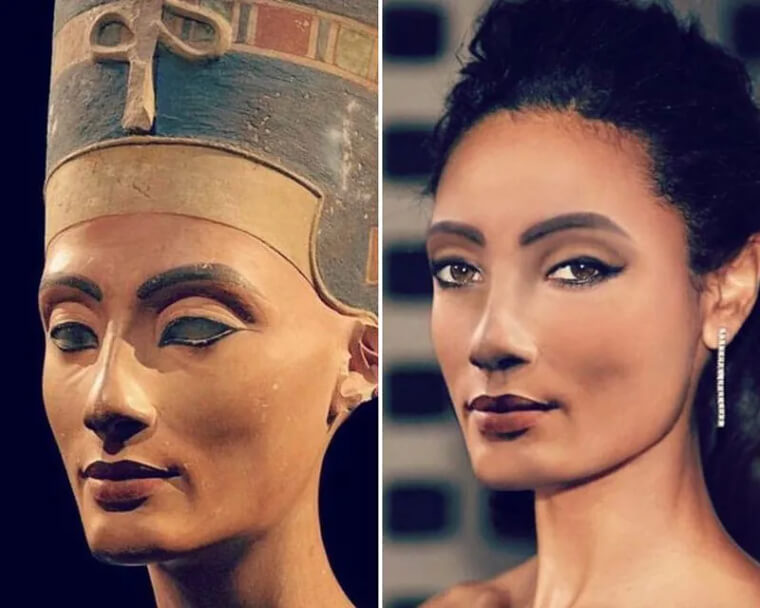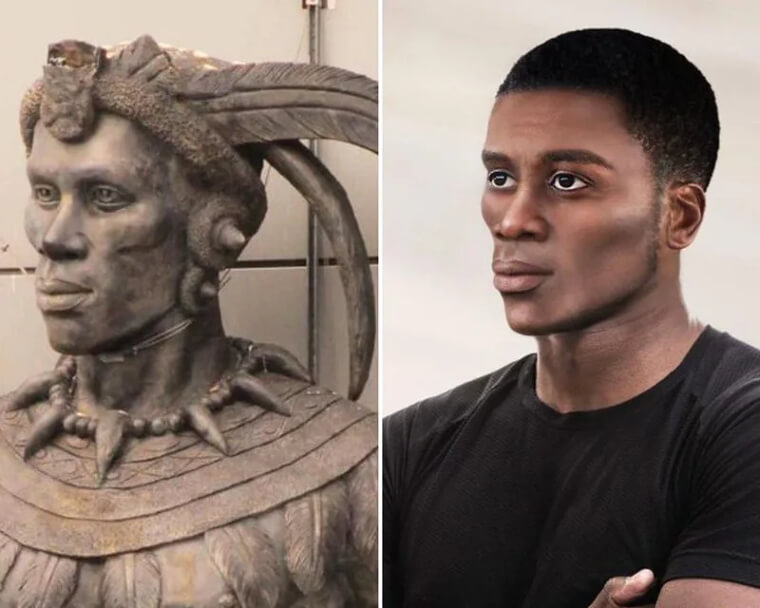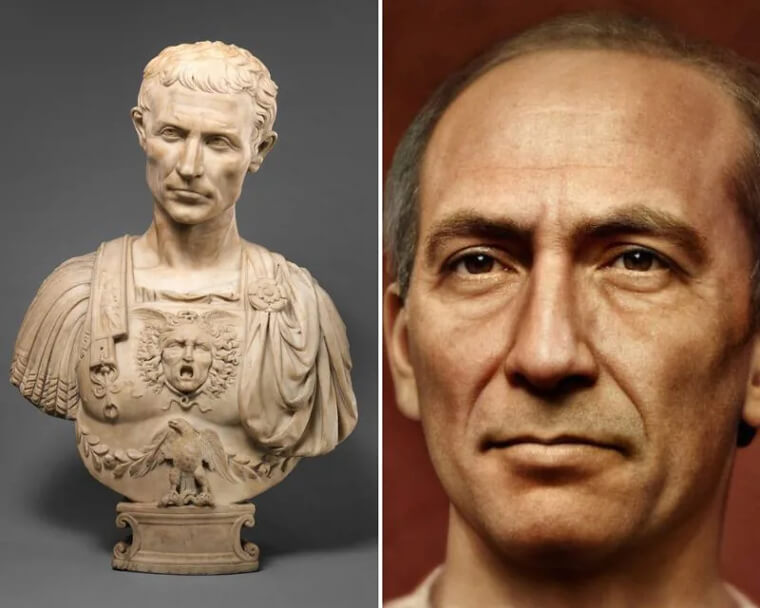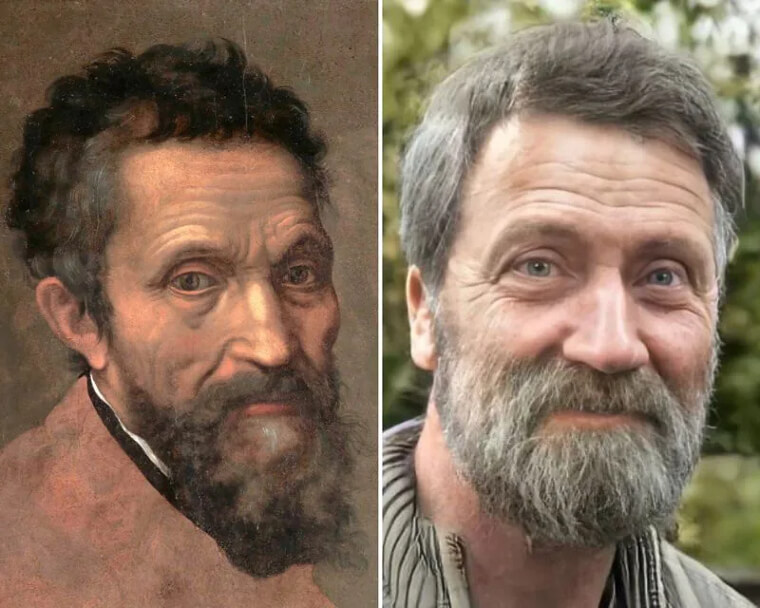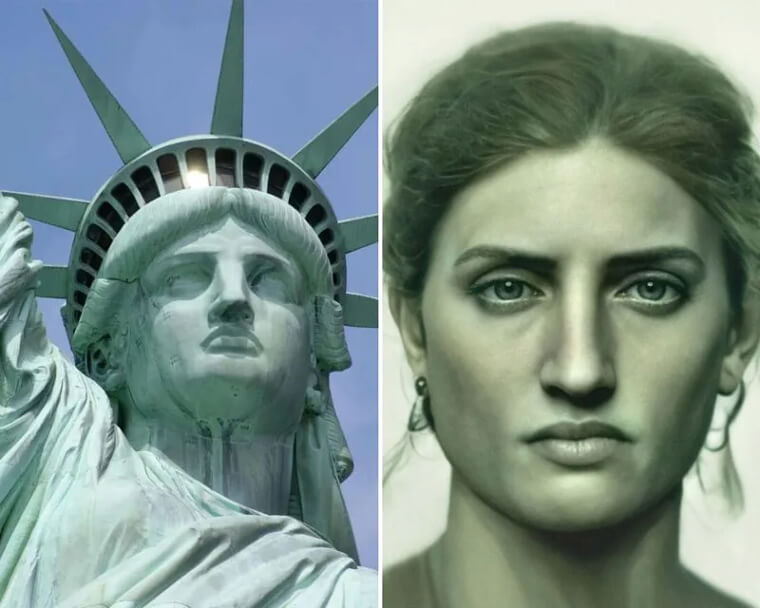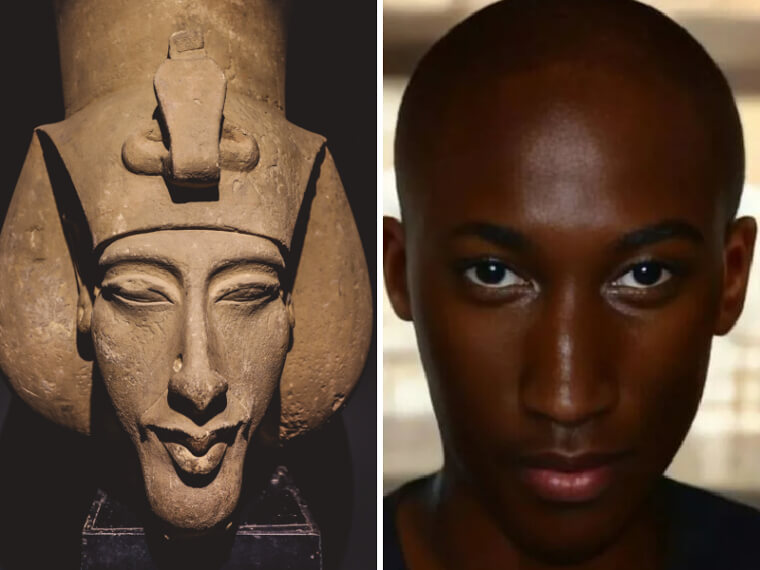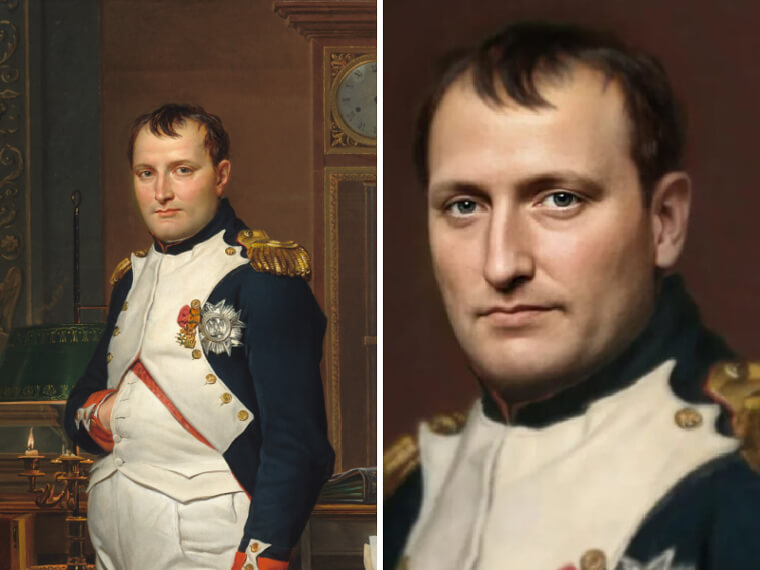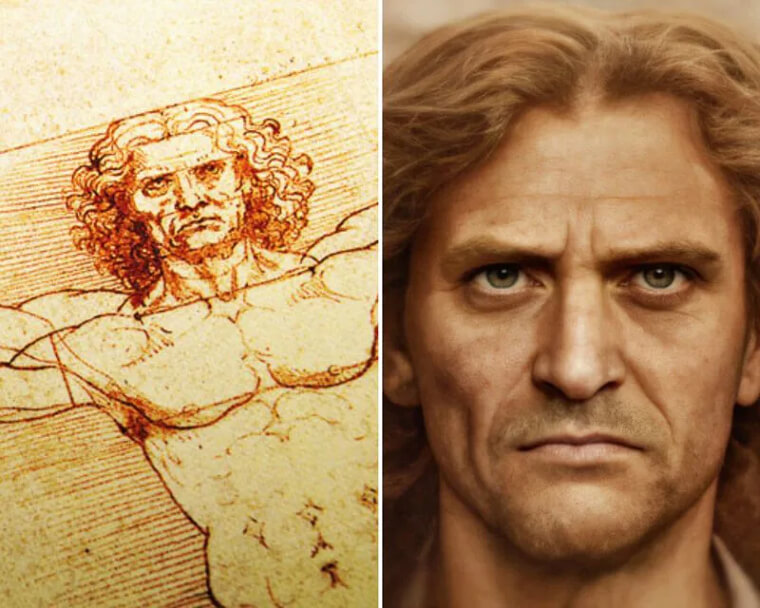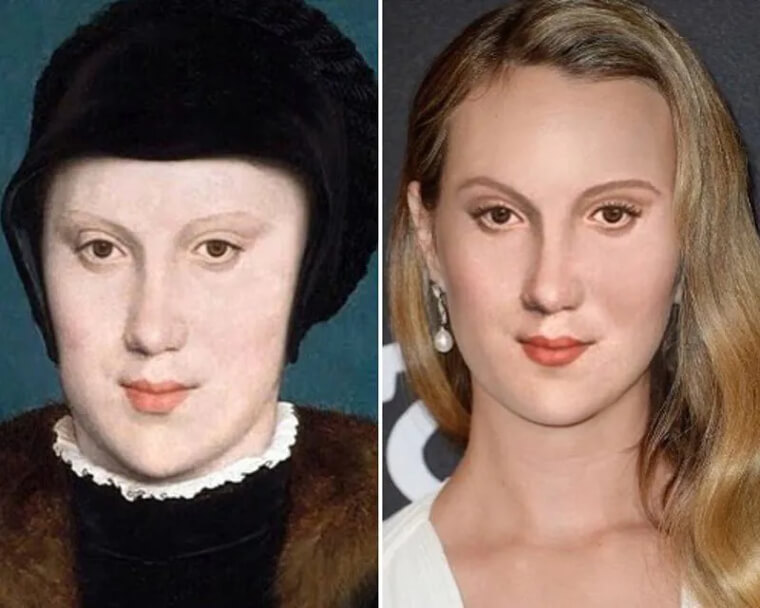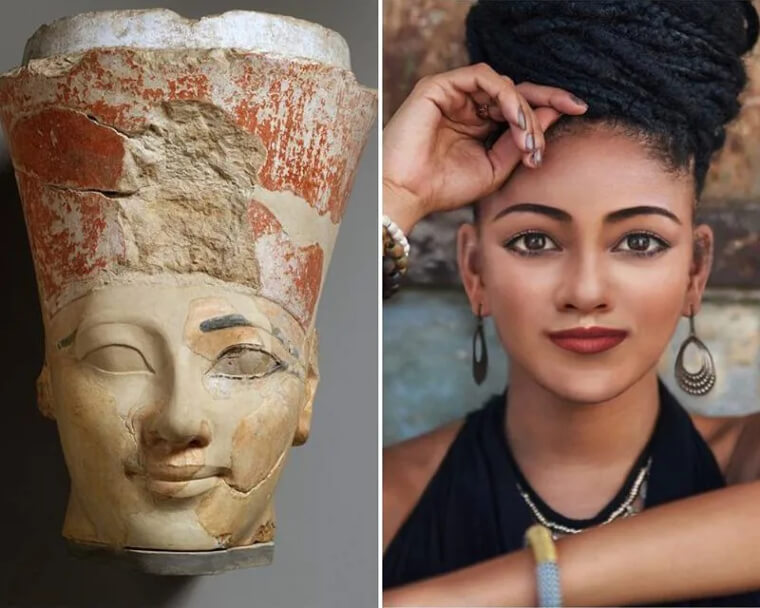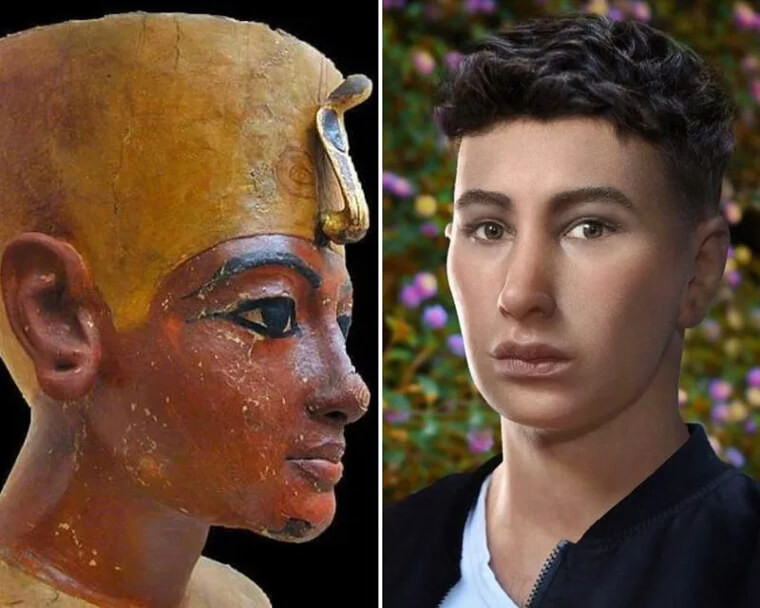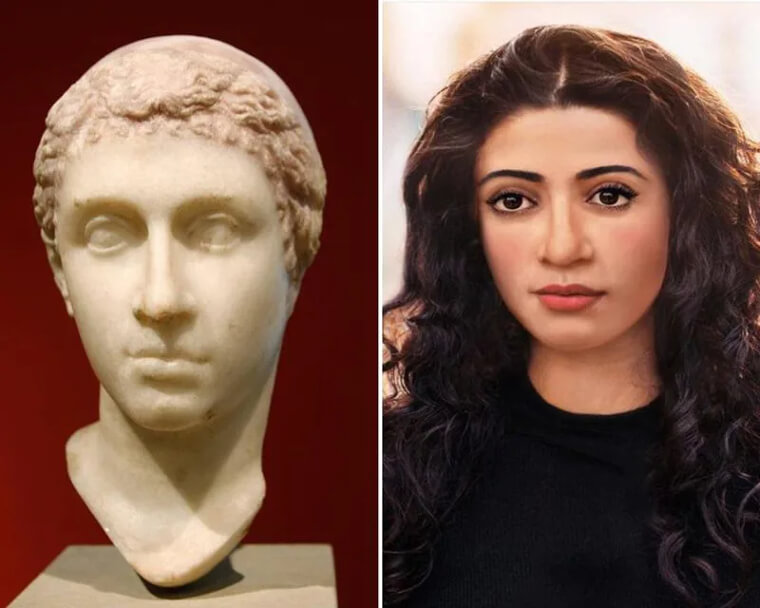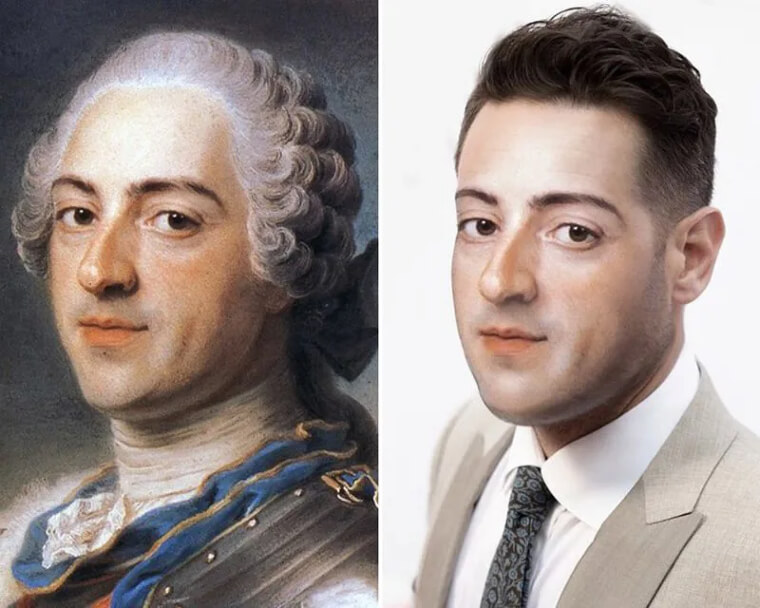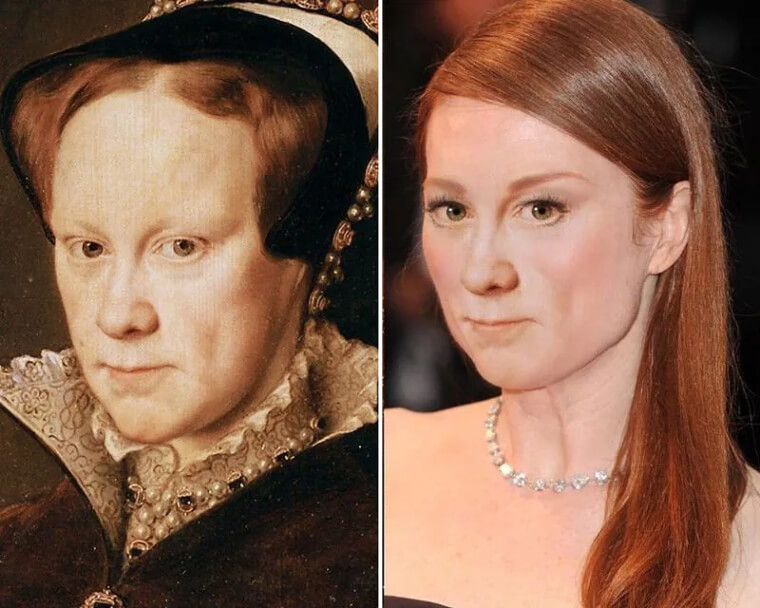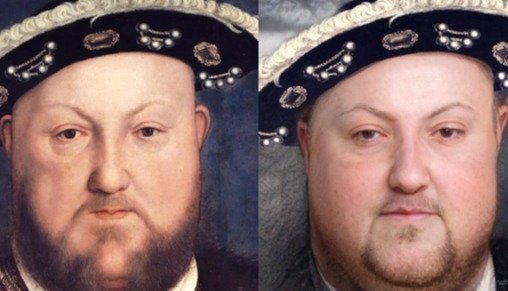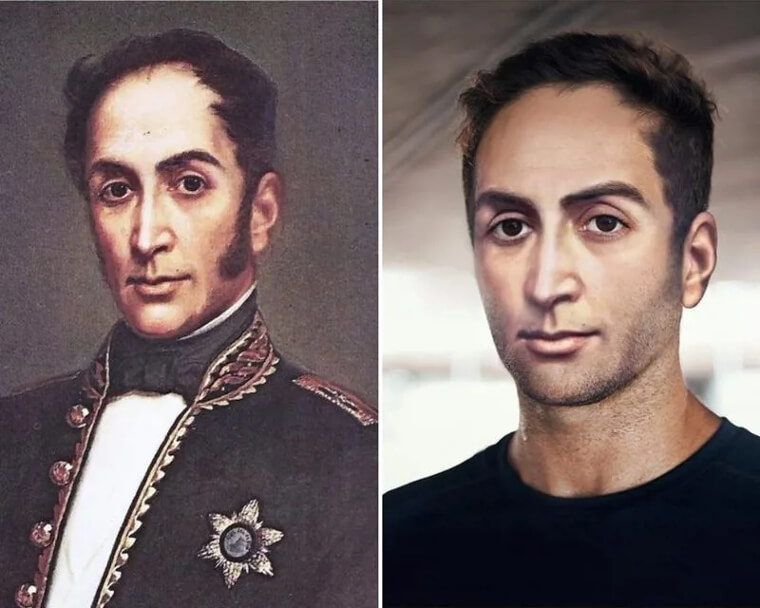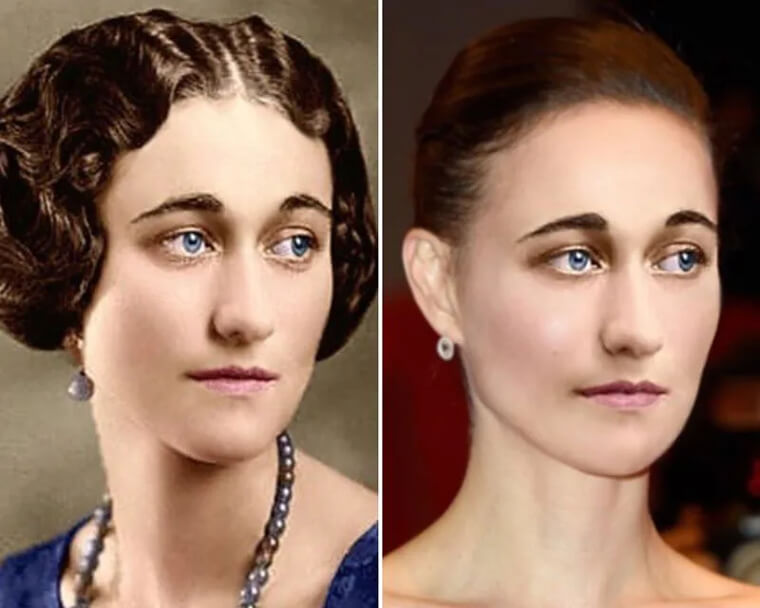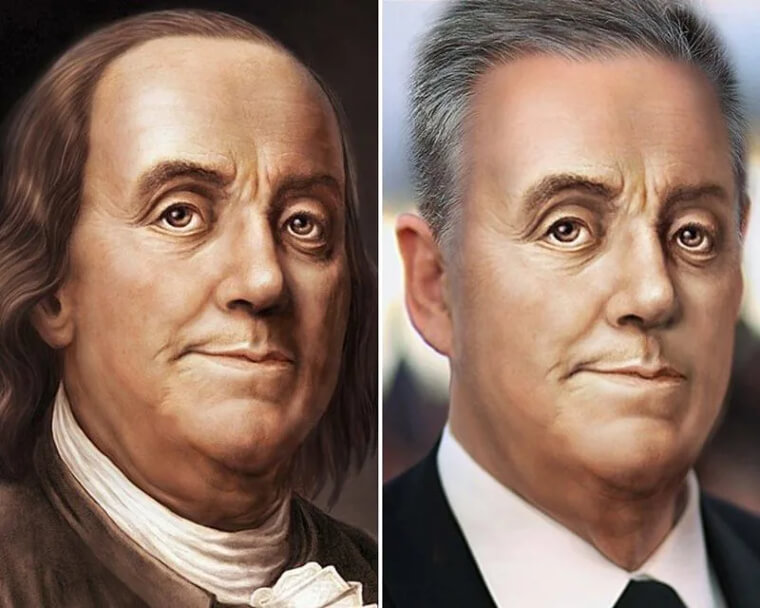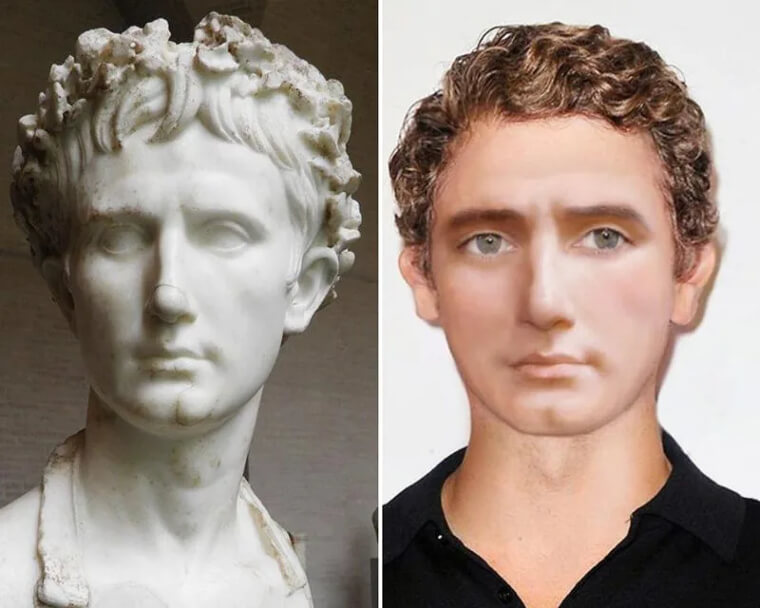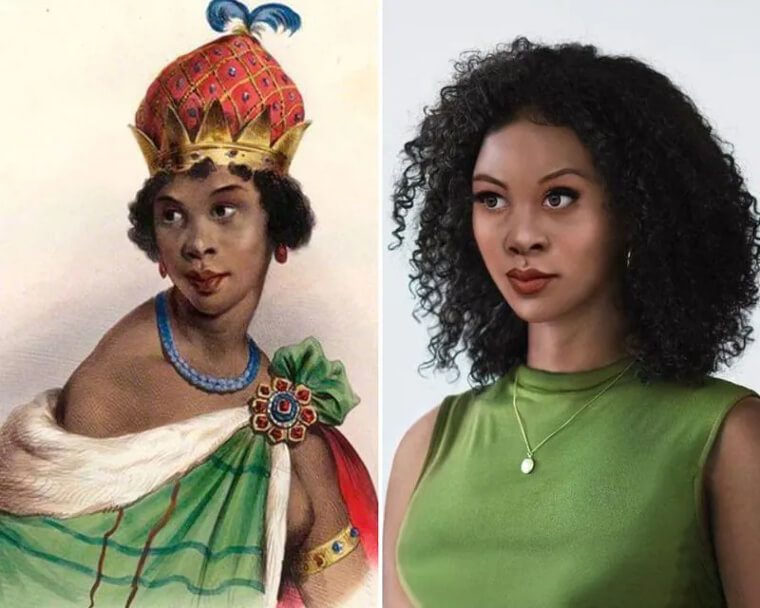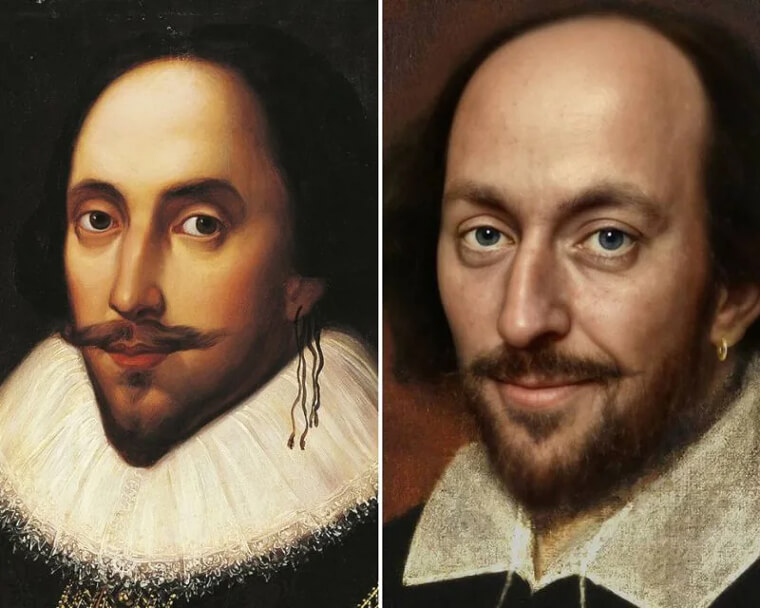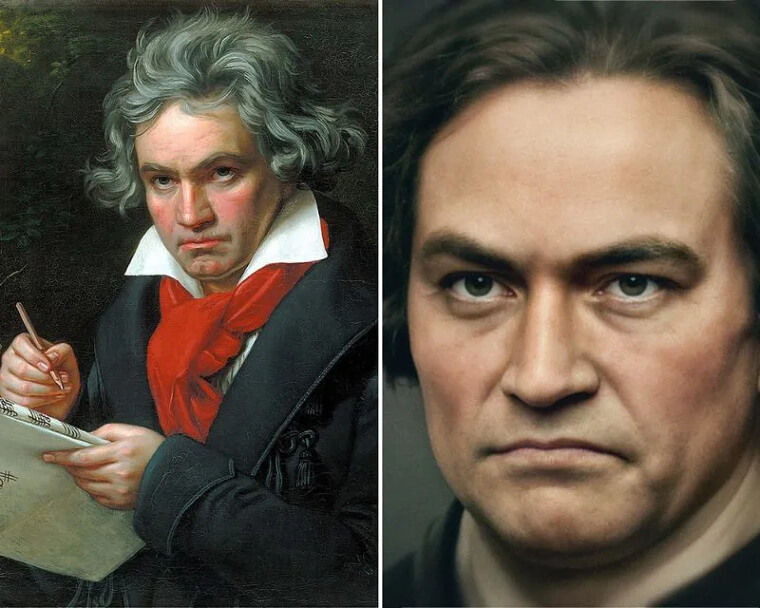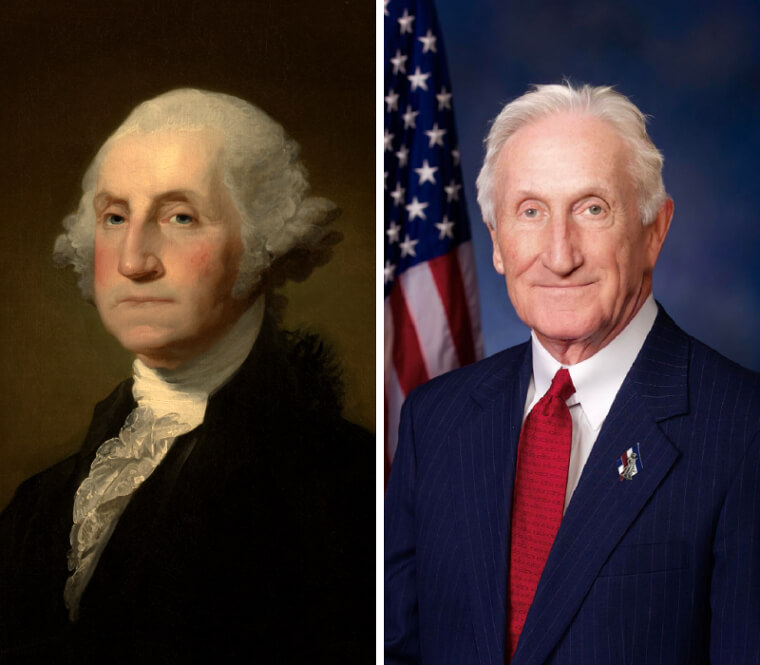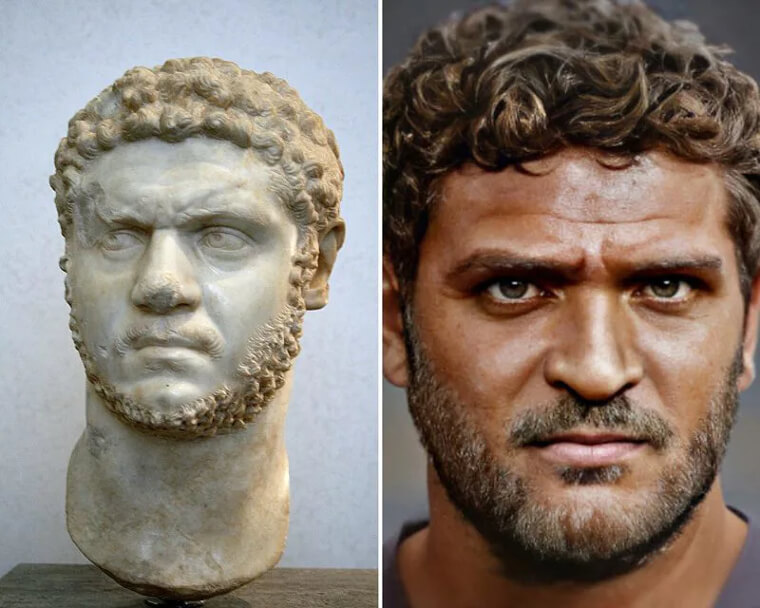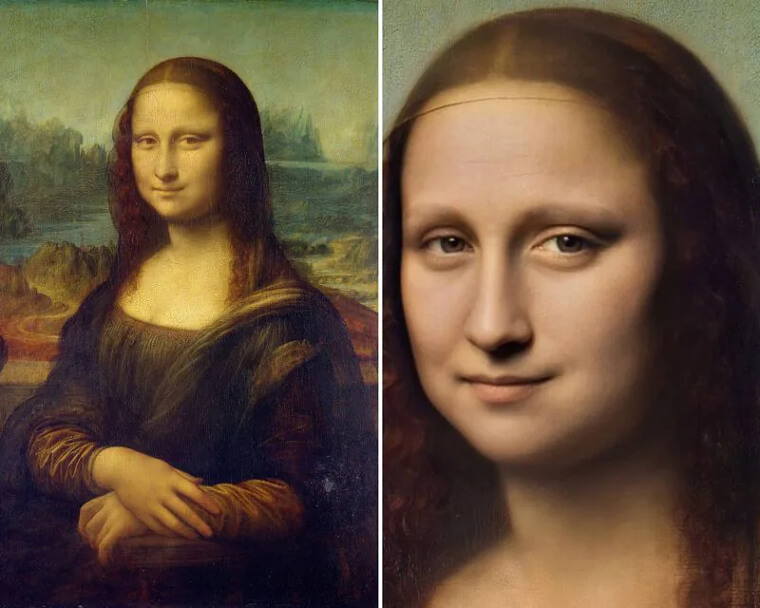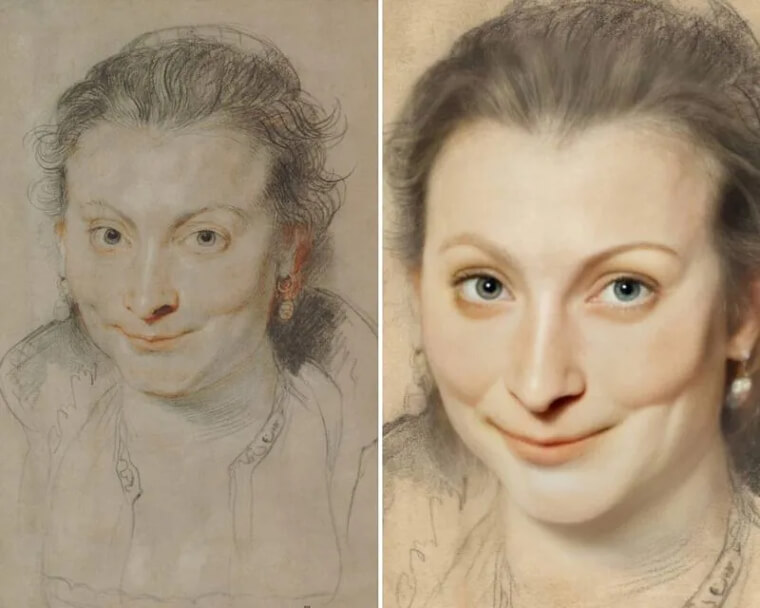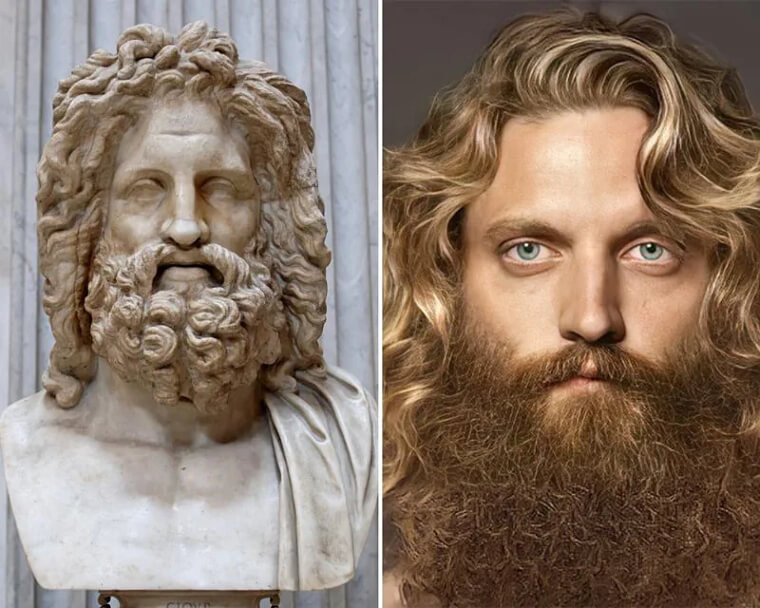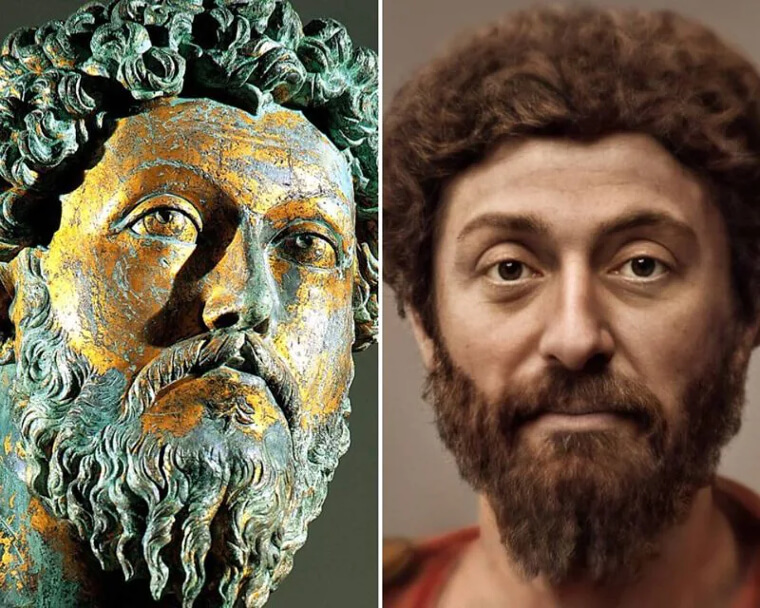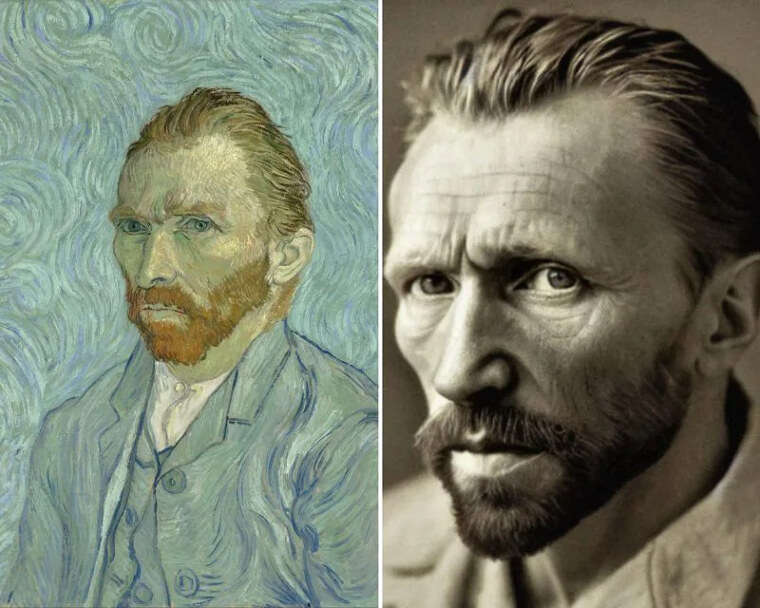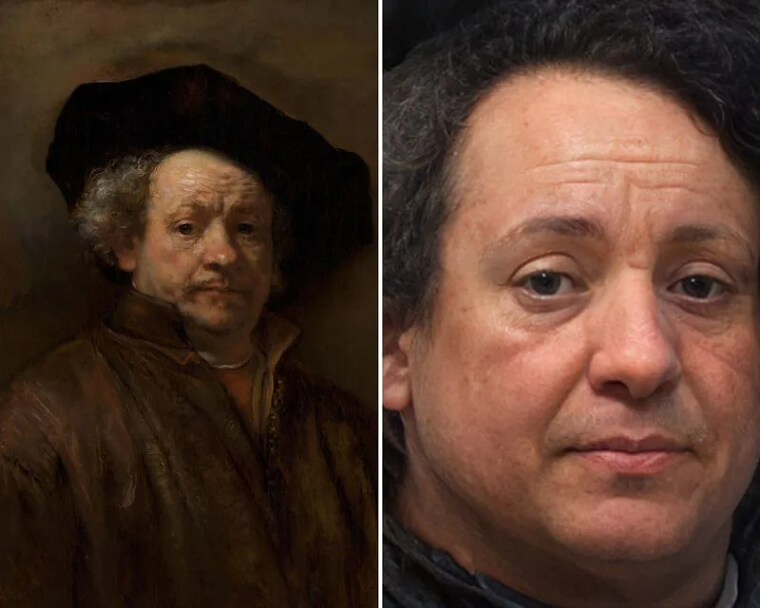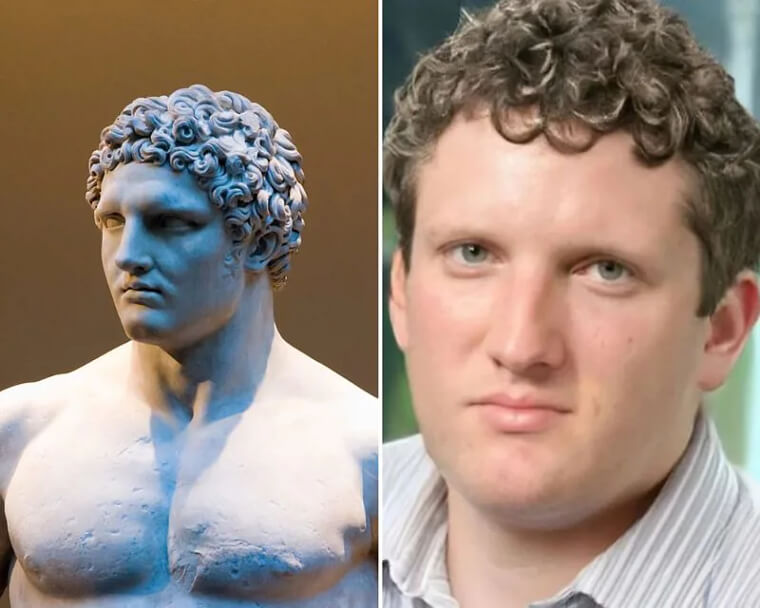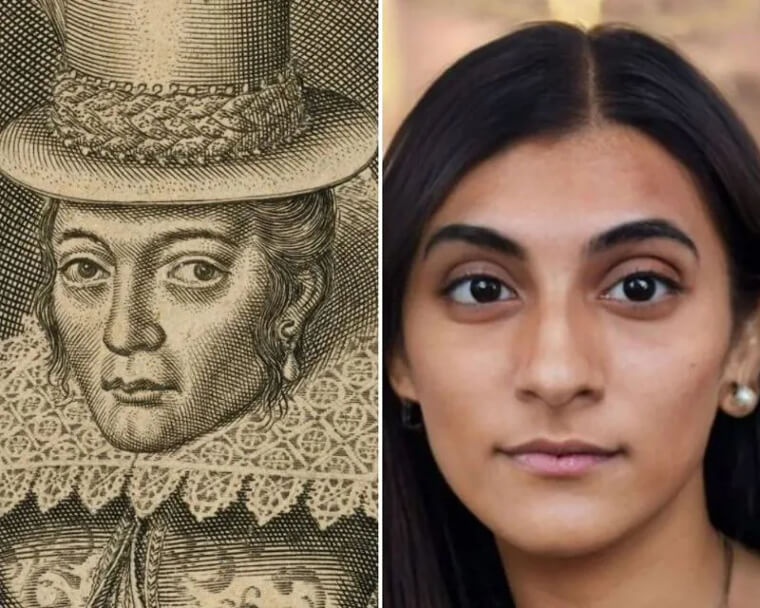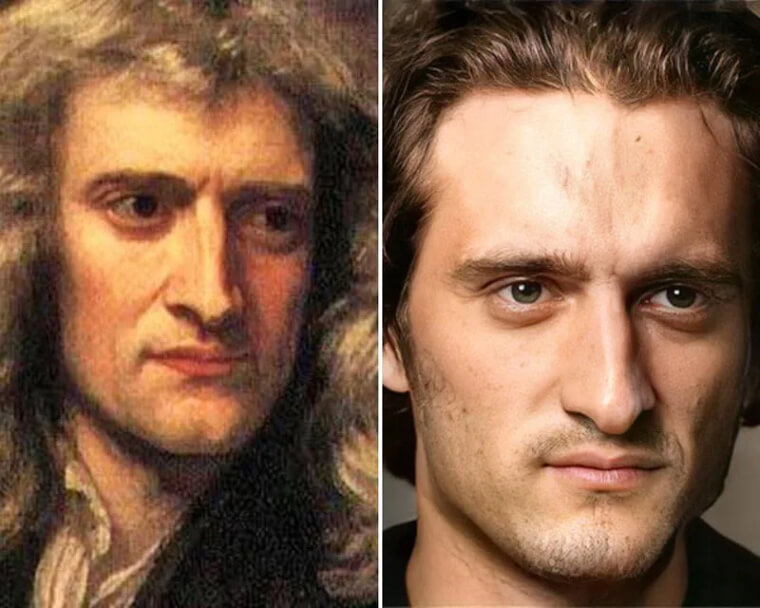Alexander The Great
One of history's greatest-ever military generals, Alexander the Great conquered the eastern Mediterranean, Egypt, the Middle East, and parts of Asia in a remarkably short period of time. Although King of Macedonia for merely 13 years, the youthful Alexander changed the course of history by ushering in significant cultural changes in the lands that formed his new empire. Alexander claimed his first military victory at the age of just 18 and never lost a battle in his 15 years of conquest.
AI's interpretation of this famous bust of the great military mind confirms his striking youthfulness. Clearly, the confidence of youth drove Alexander throughout the duration of his decorated reign.
Nefertiti Of Ancient Egypt
Queen of the 18th Dynasty of Ancient Egypt, and the great royal wife of Pharaoh Akhenaten, Neferneferuaten Nefertiti is best known for her painted sandstone bust, which was rediscovered in 1913 and became a global icon of feminine beauty and power. Thanks to AI, we can truly see the extent of the queen's extraordinary beauty — her perfect bone structure and feline features brought to life in this astonishing reimagination.
Although historians have no understanding of Nefertiti's temperament or demeanor, the AI interpretation shows her to be calm and assured. The queen's long reign as consort suggests this was the case, her wise eyes providing counsel to her husband, Pharaoh Akhenaten.
Shaka Zulu
One of the most influential monarchs of the Zulu, Shaka Zulu — full name Shaka kaSenzangakhona — ruled the Zulu Kingdom from 1816 to 1828. During his reign, the king reorganized the Zulu military and turned it into a formidable force, conquering huge swathes of land across what is modern-day South Africa. The word "shaka" means "power", and Shaka Zulu certainly lived up to his name, both in appearance and actions.
The AI technology shows Shaka Zulu to have incredibly defined cheekbones and a look of steely determination. It's no secret that the king wasn't afraid to punish his foes and his powerful-looking face tells the story. It's also incredible to note a plain black t-shirt can modernize an image so greatly.
Julius Caesar
Arguably the most famous of the Roman Emperors, Gaius Julius Caesar was a Roman general and statesman who led the Roman armies in the Gallic Wars. An outstanding military operator, Casaser went on to defeat his political rival, Pompey in a civil war and took control of the Senate, where he oversaw the transformation of Rome from a republic to an empire. The emperor, however, would end up being assassinated in one of history's most well-known acts of betrayal.
The AI version of Julius Caesar gives the impression of a man with an enormous amount of confidence and power, not dissimilar to an influential modern-day congressman or senator. You can easily picture Caesar as a character in House of Cards.
Michelangelo In The Modern Day
There's something surreal about the AI recreation of one of the most famous artists of all time — is this a work of art the Italian sculptor would approve of? Sadly, we'll never know. Born in Tuscany, the depiction of Adam's creation that adorns the Sistine Chapel's ceiling is probably the best-known of Michelangelo's works today. However, the artist thought of himself first and foremost as a sculptor.
According to AI, Michaelangelo was a rugged, handsome man with soft eyes and a friendly face. He looks hardworking, yet also like a man who would be generous with his time.
The Statue Of Liberty
One of the world's most recognizable monuments, The Statue of Liberty is a colossal neoclassical sculpture on Liberty Island in New York City's New York Harbor. Gifted to the Big Apple by the people of France, the copper statue was designed by French sculptor Frédéric Auguste Bartholdi and its metal framework was built by Gustave Eiffel — of Eiffel Tower fame. Incredibly, Lady Liberty is struck by lightning 600 times every year.
The Statue of Liberty represents a Roman goddess, and her face is actually modeled on Bartholdi's mother. Well, Madame Bartholdi must have been beautiful, as you can see how stunning the AI shows her to be, with beautiful bone structure and sensual eyes.
Pharaoh Akhenaten
While not the most famous historical figure on this list, Akhenaten is certainly one of the most controversial. An Egyptian pharaoh who ruled during the Eighteenth Dynasty of the New Kingdom period of Ancient Egypt, Akhenaten is best known for changing the traditional religion of Egypt from the worship of multiple gods to the worship of a single god named Aten. This reform to monotheism made the pharaoh incredibly unpopular with his detractors.
With the help of AI, we can get a better understanding of what Akhenaten would have looked like. The king had a long, thin, and almost model-like face with piercing eyes.
Napoleon Bonaparte
Probably the most famous short man in history, Napoleon Bonaparte is considered one of the greatest military generals in history. The French military commander and political leader — who would go on to be known by his regnal name, Napoleon I — rose to prominence during the French Revolution and led successful campaigns during the Revolutionary Wars. While the term "Napoleon complex" took its name from the Galic commander, Napoleon's actual height might not have been as short as once thought.
According to pre-metric system French measures, Napoleon was a diminutive 5'2 but was likely misleading. Still, the great general's achievements are undeniable, and this AI picture shows him to be a somewhat serious and ambitious-looking man.
Leonardo Da Vinci's Vitruvian Man
Inspired by the writings of the ancient Roman architect Vitruvius, Leonardo da Vinci's Vitruvian Man visualizes the artist/scientist's ideal vision of body proportions, in what is one of history's most iconic images ever drawn. In creating his work of art, Da Vinci sought to depict the connection of man to nature, with the man's arms reaching the sides of a circle and square. The Vitruvian Man has an incredible physique and chiseled facial features.
These facial features are recreated extraordinarily well here in the AI depiction of the famous subject, and the Vitruvian Man, as he might have looked in real life, looks every bit as impressive as Da Vinci's drawing.
Christina Of Denmark
Christina of Denmark was a Danish princess who was around in the 16th century, the younger surviving daughter of King Christian II of Denmark and Norway and Isabella of Austria. The princess would go on to become a duchess — of Milan — and then Duchess of Lorraine, both through two different marriages. Paintings of Christina aren't particularly flattering, although this could be due to the different style and beauty standards of the day.
As you can see, the AI version of the princess is almost identical to the painting it's based on, yet the release of her blonde locks and the removal of her frilly collar show Christina as a true beauty.
Genghis Khan
Born in 1162, Genghis Khan was a warrior, leader, and founder of the Mongol empire, which became the largest contiguous empire in history after his death. Considered one of the greatest, and most feared military leaders of all time, Khan came to power by uniting many of the nomadic tribes of the Mongol steppe, thus being proclaimed the universal ruler of the Mongols. The great warrior is also famous for fathering hundreds of children.
Here, thanks to AI, we see what a modern-day Genghis Khan might look like. with a sharp side parting and a determined gaze, Khan looks like a powerful politician or businessman.
Queen Hatshepsut Of Egypt
Considered one of Egypt's greatest pharaohs — male or female — Queen Hatshepsut brought great wealth and artistry to her land, responsible for one of Egypt's most successful trading expeditions, bringing back gold, ebony, and incense from a place called Punt, likely modern-day Eritrea. Hatshepsut's rule wasn't just prosperous, it was also long, reigning over ancient Egypt for 20 years. Like most successful pharaohs, the queen assembled a large, powerful army.
Incredibly, AI technology can give us a pretty accurate render of Hatshepsut from her stone statue. As you can see, the queen was a beautiful, majestic-looking woman with kind eyes.
Mark Anthony
Mark Anthony, or Marcus Antonius in his native Latin, was a Roman politician and general who played a critical role in the transformation of the Roman Republic from a republic into the autocratic Roman Empire. An accomplished military leader, Antony was a Roman general under Julius Caesar and later triumvir who ruled Rome's eastern provinces. In spite of his successful political career, Mark Anthony is probably best known for his relationship with Cleopatra, queen of Egypt.
Cleopatra was famously beautiful, yet according to AI, her lover was a fairly regular-looking guy who wouldn't look out of place in a modern-day tech company or similar.
King Tutankhamun
Tutankhamun — often referred to as King Tut — was the antepenultimate pharaoh of the 18th Dynasty of ancient Egypt, and is arguably the most famous posthumous figure in history. Unlike many of the names on this list, King Tut is best known for how his body was found, rather than what he achieved while living. Tutankhamun's tomb was discovered entirely complete, containing treasures that helped the egyptologists to better understand the process of mummification.
Tutankhamun ascended to the throne as a child ruler around the age of 9 and sadly passed away aged just 19, and his youthfulness is clear to see in this AI reimagination.
Cleopatra VII
Cleopatra VII, known more commonly as Cleopatra, was Queen of the Ptolemaic Kingdom of Egypt from 51 to 30 BC, and its last active ruler. While on the throne, Cleopatra actively influenced Roman politics at a crucial period and was especially known for her relationships with Julius Caesar and Mark Antony, making her one of the most interesting and famous historical figures of all time.
Cleopatra came to represent the prototype of the romantic femme fatale, so it's no surprise that the AI interpretation of the Egyptian queen captures her majestic beauty in a modern-day setting.
King Louis XV
Arguably as infamous as he is famous, Louis XV was king of France from 1715 to 1774 and is best known for contributing to the decline of royal authority that led to the French Revolution. Louis attempted King attempted progressive fiscal reforms that included the taxation of the nobility but his foreign policy failures weakened France. Numerous lost wars forced Louis to part ways with numerous territories, including lucrative overseas colonies.
Although he looks far less glamorous, the modern AI interpretation of Louis XV presents the king as a typical young professional, perhaps without the steeliness and confidence of more successful rulers.
Mary I Of England
When Edward VI died in 1553, there were arguments about who would succeed him. Unusually, both claimants to the throne were women, and 9 days later the radical longstanding question around whether a woman could rule the country by herself was answered. Known to be stubborn but courageous, Mary I, or Mary Tudor as she is commonly known, attempted to restore the catholic faith, her reputation becoming defined by her religious persecutions.
Although Queen Mary seems stern and severe in her Tudor-era paintings, her modern-day AI equivalent looks far more approachable and relatable. It's amazing what a change in fashion can do, too.
Henry VIII
One of the most feared rulers in British history, King Henry VIII is famous for his brutal treatment of his six wives and for his efforts to have his first marriage annulled, which led to a disagreement with the catholic church and his subsequent separating the Church of England from papal authority. Infamously, Henry sent two of his wives, Anne Boleyn and Catherine Howard, to their deaths on the executioner's block at the Tower of London.
Henry VIII is also known for his legendary appetite. The king's fuller face is translated here into a slightly more modern equivalent, but he looks almost identical to the original painting.
Simón Bolívar
South America's beloved son, Simón José Antonio de la Santísima Trinidad Bolívar y Palacios became the most powerful leader in Latin America and gained the nickname “El Libertador” for helping numerous nations become independent from Spain. Inspired by the American Revolutionary War, Bolívar's constitutional aims were to design strong links to unify the newly independent nations in Latin America. Today, July 24 is celebrated as Simon Bolivar Day throughout Latin America.
A man of extraordinary charisma, this modern-day version of the great South American soldier looks no less impressive than that of his painting. Bolívar's determined gaze is incredibly infectious.
Wallis Simpson
One of British history's most controversial women, Wallis Simpson was an American socialite who had been married twice when she met Edward, Duke of Windsor, and their intention to marry caused a constitutional crisis that led to Edward's abdication. After Edward abdicated the throne, he and the future Wallis, Duchess of Windsor, married. They traveled widely, living mostly in Paris, and frequently hosted or attended lavish parties and lived a very glamorous life until Edward's death in 1972.
It feels like the Wallis Simpson scandal is playing out again today, with Megan Markle — also an American divorcee. Like the Duchess of Sussex, Wallis Simpson was very beautiful, and AI's modern interpretation only confirms this.
Benjamin Franklin
A titan of American history, Benjamin Franklin was one of the Founding Fathers of the United States, a drafter and signer of the United States Declaration of Independence, and the first United States Postmaster General. Furthermore, Franklin was one of the leading intellectuals of his time and a world-class scientist and inventor, inventing the lightning rod, the Franklin Stove, and bifocals, to name just a few.
Arguably, there hasn't been anyone as accomplished in American politics as Franklin — his face even adorns the $100 bill. AI doesn't think he'd look much different were he alive today, although his updated haircut gives the look of a modern statesman.
Emperor Augustus
Augustus — also known as Octavian — was the first emperor of ancient Rome, who came to power after the assassination of Julius Caesar in 44 BCE. Considered one of the greatest leaders in human history, Emperor Augustus is best known for initiating the Pax Romana, a largely peaceful period of two centuries in which Rome imposed order on a world that had long been marred in conflict.
AI's interpretation of this famous bust of Octavian shows the emperor to have warm eyes and a charming gaze, his wavy hair complimenting an overall trustworthy look.
Queen Nzinga of Ndongo and Matamba
Queen Nzinga Ana de Sousa Mbande, the monarch of the Mbundu people, was a resilient leader who fought against the Portuguese colonizers and their expanding slave trade in Central Africa. Although initially accommodating to the Portuguese — Queen Nzinga even converted to Christianity — in 1627, after forming alliances with former rival states, the queen led her army against the Portuguese, initiating a thirty-year war against them that would continue to inspire the region, resulting in Angolan independence in 1975.
Nzinga Mbande was clearly an inspirational woman and AI's modern interpretation of the great warrior certainly does her justice, the queen's radiance and steely determination shining through.
William Shakespeare
Has there ever been a writer more famous than William Shakespeare? Probably not. Shakespeare is widely regarded as the greatest writer in the English language and the world's pre-eminent dramatist, dreaming up the blockbuster play of his day, including Macbeth, Romeo and Juliet, and Hamlet to name a few. These plays continue to be hugely popular to this day, being reenacted and reimagined all across the world on stage, screen, and elsewhere.
Anyone who has seen the movie Shakespeare in Love will be familiar with the writer's personal life, and this AI version of "Bill" Shakespeare helps us imagine what the great playwright would have looked like today.
Ludwig Van Beethoven
One of the most admired composers in the history of the Western European music tradition, Ludwig van Beethoven was a German musician whose works rank amongst the most performed of the classical music repertoire. Beethoven's Eroica Symphony, completed in 1804, changed the musical world and is perhaps his defining work. Still, the German maestro composed numerous symphonies that have become household pieces of music and appeared in movies and television shows.
Aside from his music, Beethoven is known for his lack of hearing, but although deaf, the composer's disability certainly didn't hold him back. The AI version of Beethoven doesn't shed much more light on his personality — he was clearly a pretty serious kind of person.
George Washington
George Washington is often called the "Father of His Country", having served not only as the first president of the United States but also as the commander of the Continental Army during the American Revolution. Once the American War of Independence had been one, Washington presided over the convention that drafted the U.S. Constitution. Aside from George Washington's military and political achievements, It was his moral character that set him apart from other men.
This moral character really comes across in the AI interpretation of the great man — a calm, thoughtful, and proudly patriotic expression is worn by modern-day Washington.
Emperor Caracalla
Marcus Aurelius Antoninus, more commonly known by his nickname, Caracalla was a Roman emperor from 198 to 217. Not as famous as the likes of Caesar, Nero, or Augustus, Caracalla was, nonetheless, an important chapter in ancient Roman history. While his principal achievements were positive and progressive — the building of colossal baths in Rome and his edict of 212, which gave Roman citizenship to all free inhabitants of the empire — Caracalla was extremely bloodthirsty.
In fact, the emperor has his brother, Geta murdered and then massacred his supporters, so that he could have free reign of Rome. Does a modern-day Caracalla look villainous? He certainly looks like he has anger issues.
Mona Lisa
One of the most famous women in history, Mona Lisa — real name Lisa del Giocondo — is of course the subject of the Italian artist, Leonardo da Vinci's iconic portrait that proudly hangs in the Louvre Museum in Paris. Considered an archetypal masterpiece of the Italian Renaissance, da Vinci completed his work in 1503, and has since become the most visited and the most written about work of all time.
We have to be honest, there doesn't seem to be a huge difference between da Vinci's original painting and this AI version of the immutable Mona Lisa. Slightly higher definition, perhaps?
Isabella Brant
A famous subject of iconic paintings and sketches, Isabella Brant was the first wife of the Flemish painter and diplomat, Peter Paul Rubens, who created several portraits of her. The most famous of these works is a portrait drawn in black and red chalk with white heightening on brown wash paper, noted historically for its "immediacy and attractiveness". Although the couple had three children, Isabella sadly died aged just 34 of the plague.
The AI does a great job here of bringing Isabella Brant to life, showing her to be warm and cheerful, with a playful glint in her eye.
Zeus God Of The Sky
A powerful figure, Zeus was the god of the sky in ancient Greek mythology. As the chief Greek deity, Zeus was considered the ruler, protector, and father of all gods and humans, and this fatherly role is typically depicted as Zeus being an older man with a full beard. As the king sitting atop the golden throne on Mount Olympus, Zeus was revered by all, including mortal kings who would boast that they were descendants of the deity.
Zeus fell in love easily, had many affairs with various women, and is often described as a strong, imposing man with a regal body and long, curly, hair. We'd say the AI got this spot on.
Marcus Aurelius
The last of the rulers known as the Five Good Emperors, and the last emperor of the Pax Romana — an age of relative peace, calmness and stability — Marcus Aurelius Antoninus ruled the Roman Empire for almost 20 years. A stoic, philosophical man, Marcus Aurelius' greatest accomplishment was his ability to hold the Empire together through its first true pandemic, as well as the Parthian War, and the Germanic Wars.
Given that, visually, Aurelius only lives on in bronze busts and stone statues, this AI recreation of the cherished emperor is very impressive and captures his thoughtfulness and stoicism well.
Vincent Van Gogh
Born in the south of the Netherlands, Vincent Willem van Gogh was a post-Impressionist painter whose work — notable for its beauty, emotion, and color — highly influenced 20th-century art. As often the case for artists, van Gogh was not particularly well-known during his lifetime, but posthumously, has become one of the most famous painters in the history of Western Art, loved for his expressive and emotive use of brilliant color.
While we celebrate van Gogh's life today, he himself struggled throughout his life with manic depression, eventually taking his own life age just 37. This remarkable recreation of the great artist vividly shows the real pain and suffering in his eyes.
Rembrandt
Rembrandt Harmenszoon van Rijn, commonly known as Rembrandt, was a Dutch Golden Age painter, printmaker, and draughtsman. Celebrated as one of the greatest visual artists of all time, the Baroque painter left behind a great legacy, distinguished by its true-to-life beauty. The Storm on the Sea of Galilee, The Anatomy Lesson of Dr. Nicolaes Tulp, and The Night Watch are some great examples of the Dutchman's work.
A once-in-a-generation talent, Rembrandt also had the ability to paint realistic self-portraits and one of these is used to recreate his face in unbelievable detail, showing us exactly what the Dutch artist would look like today.
Hercules God Of Strength
Even though his father was Zeus, ruler of all the Greek gods on Mount Olympus and all the mortals on earth, Hercules was actually born a mortal. That being said, like many mythic heroes, the Greek god of strength and heroes had a complicated family tree. Without a doubt one of the greatest mythological Greek heroes, Hercules was famous not only for his incredible strength but also for his courage and intelligence.
When people think of Hercules, they often imagine Disney's cartoon version, voiced by Tate Donovan. This AI reimagination shows the Greek god in a different light, however, with short, curly hair and a fuller face.
Thomas Jefferson
A spokesman for democracy, Thomas Jefferson was an American Founding Father, the principal author of the Declaration of Independence, and the third President of the United States. A true icon of his nation, Jefferson also found time to be a diplomat, lawyer, architect, and philosopher. However, while the former President clearly deserves a substantial footnote in the history of the United States, his ownership of hundreds of slaves somewhat contradicts his founding of a country based on principles of freedom and egalitarianism.
Often described as a family man at heart, modern-day Thomas Jefferson has the look of a loving grandfather with plenty of wisdom to impart.
Pocahontas
Pocahontas, whose real name was Matoaka (and later known as Rebecca Rolfe), was a Native American woman who is famous for helping English colonists in North America, and for her role as an ambassador between the Powhatan Chiefdom and the Jamestown colony. During this time, the daughter of an important chief reportedly saved the life of Captain John Smith, an English soldier, explorer, and colonial governor.
Anyone familiar with Disney movies will recognize Pocahontas from the 1995 movie of the same name. Portrayed in the film as a beautiful, brave young woman, the AI modern-day interpretation confirms this to be the case.
Sir Isaac Newton
|Born on Christmas Day at Woolsthorpe Manor in Woolsthorpe-by-Colsterworth, a hamlet in the English county of Lincolnshire, Sir Isaac Newton was a physicist, astronomer, alchemist, theologian, and author. Best known for formulating the theory of Gravity, legend has it that Newton had his lightbulb moment when he saw a falling apple while thinking about the forces of nature. It is estimated that Newton had an IQ score would between 190 and 200, depending on the measures used.
Not only was Isaac Newton a genius, but it would appear the mathematician was also extremely good-looking. Trading his famous long white wig for a more modern crop, Newton of today would be rugged and handsome.
Vasco Da Gama
Born in Portugal in the 15th century, Vasco da Gama was the first person to sail from Europe to India by rounding Africa's Cape of Good Hope. The 1st Count of Vidigueira landed and traded in locales along the coast of southern Africa during his voyage, and da Gama's milestone marked the beginning of a sea-based phase of global multiculturalism. The explorer would eventually succumb to malaria three months after his arrival in India.
This modern interpretation of Vasco da Gama today is fascinating. Without the fancy regalia, breastplate, and sword, da Gama looks like a regular office worker in his late thirties! We also don't get a sense of his alleged violent, rude, and relentless personality.
